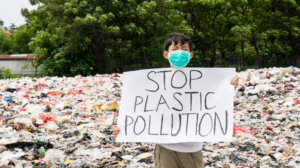- Regulatory Tools
- Circular Economy
- Government
- Government Policy
- Labelling
- Recycling
- Policy
- Strategy and Policy
- Take Action
- National
Seven Simple Ways To Reduce Your Plastic Footprint (And Why You Should Care)
Plastic bottles, carry bags, six-pack rings, plastic straws, disposable cutlery and styrofoam takeout containers—plastic products like these are so ubiquitous that we barely even notice them, let alone think of the damage they are doing to the environment.
Over 300 million tons of plastic is produced every year, 50% of which consists of single-use items like straws, stirrers, coffee cups and shopping bags. Since just around 20% of plastic is actually recycled per year globally, the majority of the plastic waste ends up in landfills. That’s not all. According to the United Nations (UN), a staggering eight million tons of this plastic trash makes its way into our oceans each year—killing approximately one million sea birds and 100,000 marine animals annually as they either become entangled in or ingest the plastic debris.
But plastic pollution is not just a threat to animals, it’s harmful to us humans, too. “Once plastic reaches the environment in the form of macro- or microplastics, it contaminates and accumulates in food chains through agricultural soils, terrestrial and aquatic food chains and the water supply. This environmental plastic can easily leach toxic additives or concentrate toxins already in the environment, making them bioavailable again for direct or indirect human exposure,” notes the Center for International Environmental Law (CIEL).
According to a study published in the journal Environmental Science and Technology, humans may be consuming between 39,000 to 52,000 microplastic particles per year thanks to microplastics found in common foods like fish, chicken, sea salt, honey, even beer. What’s more, “microplastics from beauty products and synthetic clothing fibers also end up in our drinking water,” tells Anita Vandyke, a Sydney-based environmentalist, qualified rocket scientist and author of A Zero Waste Life. Ingestion or inhalation of microplastics can lead to a number of health issues, including inflammation, genotoxicity, oxidative stress and necrosis, states CIEL.
So, what can you do to help tackle the growing plastic pollution problem?
Here, three leading zero waste lifestyle experts share the best ways to cut down your day-to-day plastic consumption:
#1 Simply, say no. “This means learning to refuse things that you do not need,” says Zero Waste Home founder, Bea Johnson. Whether it’s a free plastic straw at a café, a pen at a conference, a free toothbrush at the dentist’s or a custom plastic bag at a retail store, freebies are used to attract consumers everywhere. And more often than not, we don’t think twice before grabbing them. But what we don’t realize is that “every time we accept these items, we are creating a demand to make more,” tells Johnson. “So the next time someone offers you a plastic product—whether it’s a bag, a straw or a toy—take a moment to ask yourself, ‘do I really need this?’ You’ll find that 99% of the time, the answer is no,” says the waste-free lifestyle expert.
#2 Shop items that use little or no plastic packaging. Choose products that have minimal or no plastic packaging, suggests Lauren Singer, New York-based environmental activist and founder of the popular zero-waste lifestyle blog, Trash is for Tossers. It will not only help reduce the demand for plastic packaging (which is one of the most common single-use plastic items piling on landfills) but it will also help you save money, she tells.
#3 Buy in bulk. Both Johnson and Singer recommend buying groceries and other daily essentials in bulk. If you can’t buy in bulk at your local store, find a supplier, suggests Johnson. “Bring your own jar to the ice cream shop, a pillowcase to the bakery for your bread or take your own bottles to the winery or brewery,” she adds.



